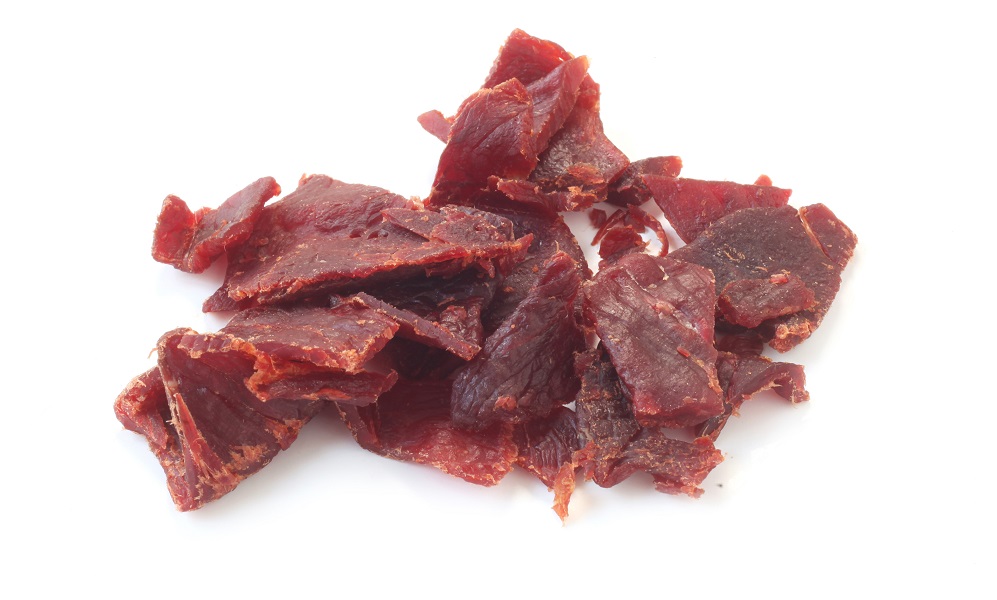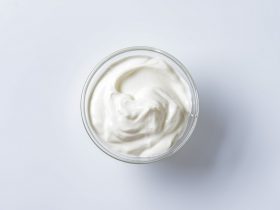Beef jerky has become one of the most popular processed meat products consumed by humans today (Luo et al., 2020), mainly due to its convenience and flavor (Nummer et al., 2004). Being a processed, salty meat, some women may be worried about eating beef jerky during pregnancy.
Beef jerky should be avoided during pregnancy because of the risk of food borne diseases from its consumption. Traditional cooking and drying techniques may be insufficient to kill pathogenic bacteria that may be present. In addition, other ingredients used in beef jerky like salt and sodium nitrite, may also be harmful with increased consumption.
Jesmarie Macapagal, RN, MD, DPPS
What is Beef Jerky?
Jerky is a snack that has been cooked and dehydrated to lengthen its shelf life and provide a unique flavor. It can be stored without refrigeration because of its low water activity (Choi et al., 2008).
Most jerky products are marinated with different seasonings. But the main ingredient is usually any dried meat that has been salted and dried as a natural preservative (Luo et al., 2020). The most common meats used are beef, pork and turkey.
To make beef jerky, the beef is sliced, then placed in a curing solution, which is typically composed of water, salt and sodium nitrite. Afterward, the meat is cooked and dried so as to reduce its moisture content to less than 50 percent of the total.

The finished product is a ready to eat (RTE) snack that needs no additional preparation. Its flavor is typically salty and strong, but other variations can be mild, savory or spicy. It is typically dark in color and has a rough texture.
Different packaging materials can be used for beef jerky. Most are packaged in a vacuum-sealed bag to preserve their freshness. A triple barrier bag can also be used, where nitrogen is added to remove all the oxygen from the whole package. Other manufacturers also offer their products inside a resealable type of zip lock that can be closed after opening.
Beef jerky is packed with nutrients, with high protein and low fat content (Kim et al., 2020). Beef meat is known for its high quality protein, iron and vitamin B (Zdanowska-Sąsiadek et al., 2018).
Risks of Eating Beef Jerky While Pregnant
Food Borne Illness
Traditional drying methods for making beef and venison jerky do not always follow the recommendation that meat should be heated to 160 degrees Fahrenheit, and poultry to 165 degrees Fahrenheit, before the dehydration process. Cooking to this temperature assures that any bacteria present will be killed.
However, most food dehydrators do not heat high enough to reach the desired temperatures. In addition, maintaining a constant dehydrator temperature of 130 to 140 degrees Fahrenheit during drying is important because the dehydrating process must be quick to dry the food before it spoils and enough water must be removed so that microorganisms will not be able to grow.
After drying, any bacteria that survive become much more heat resistant. Therefore, without the proper cooking temperature before the dehydration process, food borne pathogens can cause illness to those who will eat the jerky.
According to the U.S. Department of Agriculture Food Safety and Inspection Service (USDA-FSIS), infections with Salmonella and Escherichia coli (E. coli) can be caused by eating jerky products. Salmonella outbreaks have been associated with consumption of beef (Laufer et al., 2015) and dried beef products like beef jerky (Eidson et al., 2000).
Likewise, there is high risk for jerky to be contaminated by Staphylococcus aureus (S. aureus) (Ha et al., 2019). This pathogen is normally found on human skin (Otto, 2008) and can be cross-contaminated from hands of the staff to the jerky. S. aureus is able to produce an enterotoxin that leads to a food borne illness (Le Loir et al., 2003).
Nummer et al. in 2004 showed that traditional drying procedures were insufficient to eliminate E. coli, Salmonella, S. aureus, and Listeria monocytogenes (L. monocytogenes) in both whole-muscle and ground-meat jerky.
Lee et al. in 2015 isolated the following pathogenic microorganisms in beef jerky: E. coli, Bacillus cereus, Clostridium perfringens, Salmonella, L. monocytogenes, S. aureus, and Yersinia enterocolitica.
High Salt Content
Salt is the most commonly used ingredient among processed meat products. Its function encompasses inhibition of microbial growth, extension of shelf life, and increase in protein hydration (Han et al., 2011).
There is overwhelming evidence that excessive sodium intake can lead to high blood pressure and blood pressure-related diseases (He & MacGregor, 2010). The role of too much salt in the diet in causing hypertension, cardiovascular disease and stroke has already been established (Claas & Arnett, 2016).
In 2009, Brantsaeter et al. showed that a higher risk of preeclampsia was seen among pregnant women with a dietary pattern distinguished by increased intake of processed meat, salty snacks and sweet drinks.
Hypertensive disorders of pregnancy represent a major cause of maternal and perinatal morbidity and mortality. Preeclampsia can lead to perinatal death, preterm delivery, and intrauterine growth restriction (Sibai et al., 2005).
Nitrites as Food Additives
Sodium nitrite and potassium nitrite are commonly used in processed meat as curing mixtures. They serve to fix the color of the meat, inhibit microbial growth and provide a unique flavor (Sindelar & Milkowski, 2012).
Studies have shown that nitrites were extensively absorbed in the human body, with bioavailability close to 100 percent, after oral ingestion (Hunault et al., 2009). Acute toxic effects of sodium and potassium nitrites include relaxation of smooth muscle, vasodilation that can lead to decreased blood pressure, and methemoglobinemia (EFSA Panel on Food ANS et al., 2017).
High concentrations of methemoglobin can lead to tissue hypoxia because of decreased capacity of the blood to transport oxygen to the tissues. Cyanosis, lethargy, dyspnea, headache and tachycardia can be seen with methemoglobin concentrations of more than 20 percent. Methemoglobin concentrations more than 50 percent may lead to major tissue hypoxia and can be fatal (Mensinga et al., 2003).
Moreover, some evidence linking dietary nitrite consumption and gastric cancers were found in epidemiological studies, as well as an association between the combination of nitrite plus nitrate from processed meat consumption and colorectal cancers (EFSA Panel on Food ANS et al., 2017).
Recommendations on Eating Beef Jerky During Pregnancy
Pregnant women should avoid any food that is labeled as smoked, nova style, kippered, jerky, or lox. Other processed meat can be safe, such as hot dogs, lunch meat, cold cuts and dry sausages, as long as they have been reheated to a safe temperature of 165 degrees Fahrenheit (74 degrees Celsius) before eating. Use a food thermometer to ensure that you have reached the desired internal temperature.
According to the FSIS, commercially bought jerky can be stored for up to 12 months, while homemade jerky can be stored from 1 to 2 months. Commercially prepared jerky may be safe for the general population. But for pregnant women, it is best to avoid all jerky products.
Tips on Food Safety
- Wash hands thoroughly with soap and water before and after preparing meat products.
- Clean surfaces, equipment and utensils used to prepare food often.
- Separate raw meat, poultry and seafood from other cooked dishes to prevent cross-contamination.
- Keep meat and poultry refrigerated at 40 degrees Fahrenheit or below.
- Defrost frozen meat in the refrigerator and not on the kitchen countertop.
- Marinate meat in the refrigerator. Do not reuse the marinade.
- Cook meat and poultry to a safe minimum internal temperature of 160 and 165 degrees Fahrenheit, respectively.
- Dry meat in a food dehydrator that can maintain the temperature at 130 to 140 degrees Fahrenheit throughout the drying process.
Final Thoughts
Eating beef jerky entails a small, but significant, risk of developing food borne illnesses. Beef in jerky products is usually undercooked and does not reach the recommended safe internal temperature for cooking meat. Thus, they can contain harmful bacteria, such as Toxoplasma, Listeria, E. coli and Salmonella, and should be avoided throughout pregnancy.
Pregnancy cravings can be hard to deal with, especially when the food you are craving can cause serious harm. Eating a balanced diet that includes lean protein, reduced-fat dairy, whole grains, fruit and vegetables can help keep your mind off some potentially harmful food.
Talk to your doctor about your pregnancy diet and keep yourself and your baby safe.
References
- https://peopleschoicebeefjerky.com/blogs/news/question-what-is-jerky
- http://www.madehow.com/Volume-4/Beef-Jerky.html
- https://www.healthline.com/health/pregnancy/beef-jerky-pregnant#risks
- https://www.fsis.usda.gov/food-safety/safe-food-handling-and-preparation/meat/jerky
- https://www.fsis.usda.gov/
- Brantsaeter, A. L., Haugen, M., Samuelsen, S. O., Torjusen, H., Trogstad, L., Alexander, J., …, & Meltzer, H. M. (2009). A dietary pattern characterized by high intake of vegetables, fruits, and vegetable oils is associated with reduced risk of preeclampsia in nulliparous pregnant Norwegian women. The Journal of Nutrition 139(6), 1162-1168. doi: 10.3945/jn.109.104968
- Choi, J. H., Jeong, J. Y., Han, D. J., Choi, Y. S., Kim, H. Y., Lee, M. A., …, & Kim, C. J. (2008). Effects of pork/beef levels and various casings on quality properties of semi-dried jerky. Meat Science 80(2), 278-286. doi: 10.1016/j.meatsci.2007.11.028
- Claas, S., & Arnett, D. (2016). The role of healthy lifestyle in the primordial prevention of cardiovascular disease. Current Cardiology Reports 18(6), 56. doi: 10.1007/s11886-016-0728-7
- EFSA Panel on Food Additives and Nutrient Sources added to Food (ANS), Mortensen, A., Aguilar, F., Crebelli, R., Di Domenico, A., Dusemund, B., …, & Younes, M. (2017). Re-evaluation of potassium nitrite (E 249) and sodium nitrite (E 250) as food additives. EFSA Journal 15(6), e04786. doi: 10.2903/j.efsa.2017.4786
- Eidson, M., Swell, C. M., Graves, G., & Olson, R. (2000). Beef jerky gastroenteritis oubreaks. Journal of Environmental Health 62(6), 9. https://web.b.ebscohost.com/abstract?direct=true&profile=ehost&scope=site&authtype=crawler&jrnl=00220892&AN=2812305&h=ZLye6hNxERUCxmBmIM%2fR8Z%2fgQtK%2fJkIrr%2fC0hjUv5xWFrCAUI96bAS1nFXAB0i3jXyn1eYef76Y8vxvImdHR7Q%3d%3d&crl=c&resultNs=AdminWebAuth&resultLocal=ErrCrlNotAuth&crlhashurl=login.aspx%3fdirect%3dtrue%26profile%3dehost%26scope%3dsite%26authtype%3dcrawler%26jrnl%3d00220892%26AN%3d2812305
- Ha, J., Lee, J., Lee, S., Kim, S., Choi, Y., Oh, H., …, & Yoon, Y. (2019). Mathematical models to describe the kinetic behavior of Staphylococcus aureus in jerky. Food Science of Animal Resources 39(3), 371-378. doi: 10.5851/kosfa.2019.e28
- Han, D. J., Lee, E. S., Lee, S. K., & Kim, C. J. (2011). Effects of hot boning and soy sauce on the processing properties of semi-dried beef jerky. Korean Journal for Food Science of Animal Resources 31(4), 497-505. https://doi.org/10.5851/kosfa.2011.31.4.497
- He, F., & MacGregor, G. (2010). Reducing population salt intake worldwide: From evidence to implementation. Progress in Cardiovascular Diseases 52(5), 363-382. doi: 10.1016/j.pcad.2009.12.006
- Hunault, C., van Velzen, A., Sips, A. J., Schothorst, R., & Meulenbelt, J. (2009). Bioavailability of sodium nitrite from an aqueous solution in healthy adults. Toxicology Letters 190(1), 48-53. doi: 10.1016/j.toxlet.2009.06.865
- Kim, T. K., Kim, H. W., Lee, Y. Y., Jang, H. W., Kim, Y. B., & Choi, Y. S. (2020). Quality characteristics of duck jerky: Combined effects of collagen and konjac. Poultry Science 99(1), 629-636. doi: 10.3382/ps/pez561
- Laufer, A. S., Grass, J., Holt, K., Whichard, J. M., Griffin, P. M., & Gould, L. H. (2015). Outbreaks of Salmonella infections attributed to beef: United States, 1973-2011. Epidemiology and Infection 143(9), 2003-2013. doi: 10.1017/S0950268814003112
- Lee, N. K., Kim, H. W., Lee, J. Y., Ahn, D. U., Kim, C. J., & Paik, H. D. (2015). Antimicrobial effect of nisin against Bacillus cereus in beef jerky during storage. Korean Journal for Food Science of Animal Resources 35(2), 272-276. doi: 10.5851/kosfa.2015.35.2.272
- Le Loir, Y., Baron, F., & Gautier, M. (2003). Staphylococcus aureus and food poisoning. Genetics and Molecular Research 2(1), 63-76. http://www.funpecrp.com.br/gmr/year2003/vol1-2/sim0009_full_text.htm
- Luo, Y., Zhao, L., Xu, J., Su, L., Jin, Z., Su, R., & Jin, Y. (2020). Effect of fermentation and postcooking procedure on quality parameters and volatile compounds of beef jerky. Food Science & Nutrition 8(5), 2316-2326. doi: 10.1002/fsn3.1515
- Mensinga, T., Speijers, G., & Meulenbelt, J. (2003). Health implications of exposure to environmental nitrogenous compounds. Toxicological Reviews 22(1), 41-51. doi: 10.2165/00139709-200322010-00005
- Nummer, B., Harrison, J., Harrison, M., Kendall, P., Sofos, J., & Andress, E. (2004). Effects of preparation methods on the microbiological safety of home-dried meat jerky. Journal of Food Protection 67(10), 2337-2341. doi: 10.4315/0362-028x-67.10.2337
- Otto, M. (2008). Staphylococcal biofilms. Current Topics in Microbiology and Immunology 322, 207-228. doi: 10.1007/978-3-540-75418-3_10
- Sibai, B., Dekker, G., & Kupferminc, M. (2005). Pre-eclampsia. Lancet 365(9461), 785-799. doi: 10.1016/S0140-6736(05)17987-2
- Sindelar, J., & Milkowski, A. (2012). Human safety controversies surrounding nitrate and nitrite in the diet. Nitric Oxide 26(4), 259-266. doi: 10.1016/j.niox.2012.03.011
- Zdanowska-Sąsiadek, Z., Marchewka, J., Horbańczuk, J. O., Wierzbicka, A., Lipińska, P., Jόźwik, A., Atanasov, A., …, & Hoffman, L. (2018). Nutrients composition in fit snacks made from ostrich, beef and chicken dried meat. Molecules 23(6), 1267. doi: 10.3390/molecules23061267




